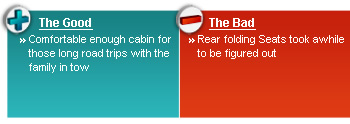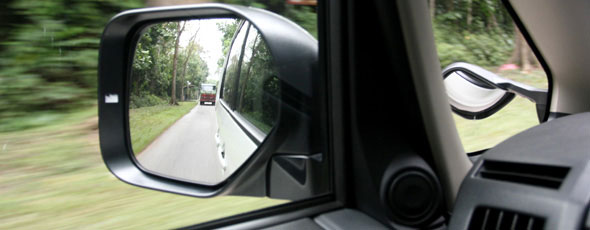Mitsubishi Delica D5 Review
07 Mar 2008|52,266 views
 |
At first glance
When the ed. team came face to face with the Delica, it brought back memories of vehicles past. We're talking about the chunky, box like designs that the Japanese started with. In fact, the L300 panel van available in local shores was known as the Delica overseas.
To be fair, the test car assigned to us was shod with a tough looking bodykit and star wars look-alike fog lamps. Aesthetically it resembled a raging bull raring to go rather than a cow waiting to be milked (ed. Pun intended or not, we don't want to know!). Of course, it did look like a cross between the current Mitsubishi Colt and the Suzuki APV, only larger, chunkier and more spacious.
Tapping our knuckles against the body revealed a rather solid steel structure that responded with a heavy, resounding echo, an approving tone of a sturdy, well made frame. Safety and security shouldn't be a concern, yet™
First, a passenger's point of view™
Digging for a list of superlatives in an effort to describe the Delica's exterior may have been tough, but it was not to be the case when it sitting inside of the vehicle.
The remote key came with 2 unusual side buttons much like a miniature centre-punch to open up the electric sliding doors on BOTH sides. This became an unusual plaything for us - we derived a very childish sense of pleasure from opening, and closing these doors repeatedly throughout the photo-shoot. Well, most motoring journalists aren't grown up boys anyway.
Without using the key, these doors can be activated from the inside and outside of the car by means of a gentle pull as well.
 |
FYI: The middle-row seats were designed to induce sleep. Once settled in, almost anyone would feel as if they were teleported back into their own living room. The seats were (surprise!) heavenly by Japanese people carrier standards, almost Citroen like in terms of comfort.
Combine that with air conditioning vents at both the top left and right corners of the roof, and you get the impression that this Delica is absolutely suited to any sort of Malaysian road trip. A nice, huge LCD-audio interface up front and a DVD player for in the back - nice touches for the kids. Unfortunately, you might need to twist your neck a little in order to get a good view of the screen, and it is best viewed by passengers from the third row.
Besides, the air-conditioning controls are within reach too.
The only problem is this - while the experienced motoring journalist who has seen the likes of 1001 MPVs fared better, the typical, unsuspecting family man that we pulled aside for an impromptu versatility test took TEN whole minutes to fold the back row of seats up, despite instructions that were pasted behind. We might blame the mechanical workings of the system, or the fact that they were plain hard to operate, but using a little lubrication might help.
Not every dad is as muscular as Vin Diesel.
..then both the driver and front passenger's point of view
The dashboard and console design is simple yet elegant, and the Grandis sourced leather wheel is sturdy, comfortable and simply feels good in our hands. The Outlander/Lancer EX style meters display everything the enlightened father needs in the twenty-first century such as trip meter information, temperature, service intervals and so forth.
What might need working on would be the quality of the dashboard plastics and roofing material used. They were also hollow to the touch, and for a car in it's price range, we felt that better materials could have been used.
The dashboard and multiple cup holders add a degree of unpretentiousness, so do the triple sunroofs to which our light hating editorial team quickly scoffed at due to their nocturnal nature.
Reversing was also a breeze with a reverse camera fitted to our test car. Sensors on all four corners of the vehicle prevented yours truly from adding scratches to "pure white" whilst crawling up narrow multi storey car parks.
The kind people at Mitsubishi Cycle & Carriage informed us that the built in DVD was also equipped with a GPS navigation system, a plight that had us reach our destination by the time we figured how to operate that piece of equipment
 |
The "performance" test
Although we would refrain saying that this MPV has a relatively high center of gravity, it isn't exactly a sedan, and fitted with an INVECS-III 6 speed CVT transmission, handling would be an interesting curiosity. The parking brake is operate via foot, and once we dispensed with that, the huge panzer rumbled, or should we say it was more like "buzzed" due to the aural nature of the engine, out onto the main road. The Delica picked up speed with surprising swiftness and 70km/h was available with utmost ease.
A vehicle with a kerb weight of 1740kg, 170bhp at 6000rpm, and 226Nm at 4100rpm coming from a 2.4-litre DOHC wasn't expected to be this rapid.
At full throttle, the engine barks like a puny but fiery drill sergeant from one's NS days. But there's no denying the surprise and excitement upon seeing a boxy contraption on four wheels hit 0-100 in 11 seconds flat.
The paddle shifters do give one the sense that he or she might be a little bit closer to Jensen Button for a couple of seconds, but the car is best left to it's own shifting devices. The seamless power transmission of the CVT kept the engine in the torque and MIVEC power-band with ease.
Pushed through winding roads, our Japanese tank's center of gravity started to remind us that this was a family transporter and not a sports sedan. The McPherson Strut, coil spring combination was not tuned for the ultimate driving machine, but rather, to keep everyone asleep for hours on end.
As for start-stop urban traffic conditions and that sudden burst of speed to scurry away from impatient truck drivers and cabbies, the Delica has proven its mettle, although the engine noise might be something that Mitsubishi will want to have look at very soon.
Should you buy it?
As of 6th March 2008, the Delica "Roadest" with it's aggressive skirting, as pictured, retails for $111,988. Its nearest rival, the Toyota Estima Aeras retails at $111,000. Of course, a family who isn't too bothered about design or appearances could save $6,000 and go for the normal Delica D:5.
The facts are there. This is an unpretentious vehicle that transports everyone effectively and safely (unless one gets hit by a prime mover). It is also a carriage chock full of entertainment for the whole family, and while its exterior styling is debatable, one should never judge a book by its cover. Not with this one at least.
 |
At first glance
When the ed. team came face to face with the Delica, it brought back memories of vehicles past. We're talking about the chunky, box like designs that the Japanese started with. In fact, the L300 panel van available in local shores was known as the Delica overseas.
To be fair, the test car assigned to us was shod with a tough looking bodykit and star wars look-alike fog lamps. Aesthetically it resembled a raging bull raring to go rather than a cow waiting to be milked (ed. Pun intended or not, we don't want to know!). Of course, it did look like a cross between the current Mitsubishi Colt and the Suzuki APV, only larger, chunkier and more spacious.
Tapping our knuckles against the body revealed a rather solid steel structure that responded with a heavy, resounding echo, an approving tone of a sturdy, well made frame. Safety and security shouldn't be a concern, yet™
First, a passenger's point of view™
Digging for a list of superlatives in an effort to describe the Delica's exterior may have been tough, but it was not to be the case when it sitting inside of the vehicle.
The remote key came with 2 unusual side buttons much like a miniature centre-punch to open up the electric sliding doors on BOTH sides. This became an unusual plaything for us - we derived a very childish sense of pleasure from opening, and closing these doors repeatedly throughout the photo-shoot. Well, most motoring journalists aren't grown up boys anyway.
Without using the key, these doors can be activated from the inside and outside of the car by means of a gentle pull as well.
 |
FYI: The middle-row seats were designed to induce sleep. Once settled in, almost anyone would feel as if they were teleported back into their own living room. The seats were (surprise!) heavenly by Japanese people carrier standards, almost Citroen like in terms of comfort.
Combine that with air conditioning vents at both the top left and right corners of the roof, and you get the impression that this Delica is absolutely suited to any sort of Malaysian road trip. A nice, huge LCD-audio interface up front and a DVD player for in the back - nice touches for the kids. Unfortunately, you might need to twist your neck a little in order to get a good view of the screen, and it is best viewed by passengers from the third row.
Besides, the air-conditioning controls are within reach too.
The only problem is this - while the experienced motoring journalist who has seen the likes of 1001 MPVs fared better, the typical, unsuspecting family man that we pulled aside for an impromptu versatility test took TEN whole minutes to fold the back row of seats up, despite instructions that were pasted behind. We might blame the mechanical workings of the system, or the fact that they were plain hard to operate, but using a little lubrication might help.
Not every dad is as muscular as Vin Diesel.
..then both the driver and front passenger's point of view
The dashboard and console design is simple yet elegant, and the Grandis sourced leather wheel is sturdy, comfortable and simply feels good in our hands. The Outlander/Lancer EX style meters display everything the enlightened father needs in the twenty-first century such as trip meter information, temperature, service intervals and so forth.
What might need working on would be the quality of the dashboard plastics and roofing material used. They were also hollow to the touch, and for a car in it's price range, we felt that better materials could have been used.
The dashboard and multiple cup holders add a degree of unpretentiousness, so do the triple sunroofs to which our light hating editorial team quickly scoffed at due to their nocturnal nature.
Reversing was also a breeze with a reverse camera fitted to our test car. Sensors on all four corners of the vehicle prevented yours truly from adding scratches to "pure white" whilst crawling up narrow multi storey car parks.
The kind people at Mitsubishi Cycle & Carriage informed us that the built in DVD was also equipped with a GPS navigation system, a plight that had us reach our destination by the time we figured how to operate that piece of equipment
 |
The "performance" test
Although we would refrain saying that this MPV has a relatively high center of gravity, it isn't exactly a sedan, and fitted with an INVECS-III 6 speed CVT transmission, handling would be an interesting curiosity. The parking brake is operate via foot, and once we dispensed with that, the huge panzer rumbled, or should we say it was more like "buzzed" due to the aural nature of the engine, out onto the main road. The Delica picked up speed with surprising swiftness and 70km/h was available with utmost ease.
A vehicle with a kerb weight of 1740kg, 170bhp at 6000rpm, and 226Nm at 4100rpm coming from a 2.4-litre DOHC wasn't expected to be this rapid.
At full throttle, the engine barks like a puny but fiery drill sergeant from one's NS days. But there's no denying the surprise and excitement upon seeing a boxy contraption on four wheels hit 0-100 in 11 seconds flat.
The paddle shifters do give one the sense that he or she might be a little bit closer to Jensen Button for a couple of seconds, but the car is best left to it's own shifting devices. The seamless power transmission of the CVT kept the engine in the torque and MIVEC power-band with ease.
Pushed through winding roads, our Japanese tank's center of gravity started to remind us that this was a family transporter and not a sports sedan. The McPherson Strut, coil spring combination was not tuned for the ultimate driving machine, but rather, to keep everyone asleep for hours on end.
As for start-stop urban traffic conditions and that sudden burst of speed to scurry away from impatient truck drivers and cabbies, the Delica has proven its mettle, although the engine noise might be something that Mitsubishi will want to have look at very soon.
Should you buy it?
As of 6th March 2008, the Delica "Roadest" with it's aggressive skirting, as pictured, retails for $111,988. Its nearest rival, the Toyota Estima Aeras retails at $111,000. Of course, a family who isn't too bothered about design or appearances could save $6,000 and go for the normal Delica D:5.
The facts are there. This is an unpretentious vehicle that transports everyone effectively and safely (unless one gets hit by a prime mover). It is also a carriage chock full of entertainment for the whole family, and while its exterior styling is debatable, one should never judge a book by its cover. Not with this one at least.
Car Information
Mitsubishi Delica D5 2.4 G 8-Seater (A)
CAT B|Petrol|9.8km/L
Horsepower
127kW (170 bhp)
Torque
226 Nm
Acceleration
-
This model is no longer being sold by local distributor
All Used Mitsubishi Delica D5Thank You For Your Subscription.




















